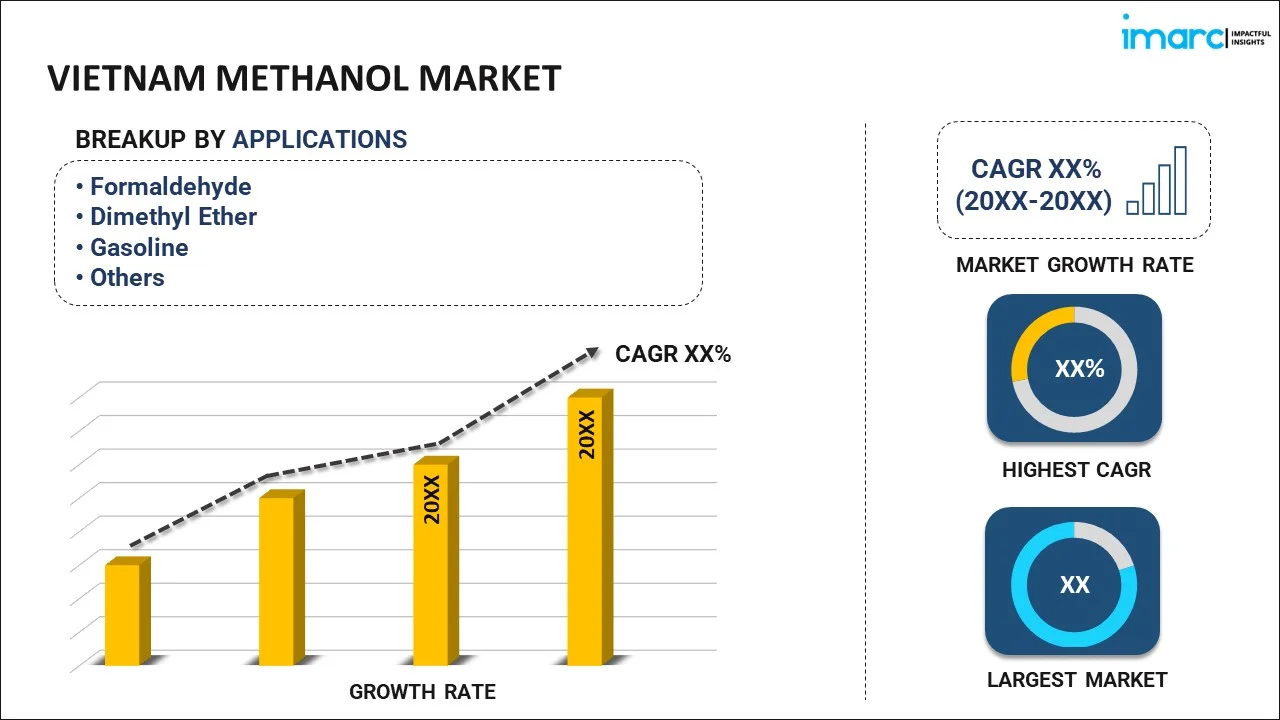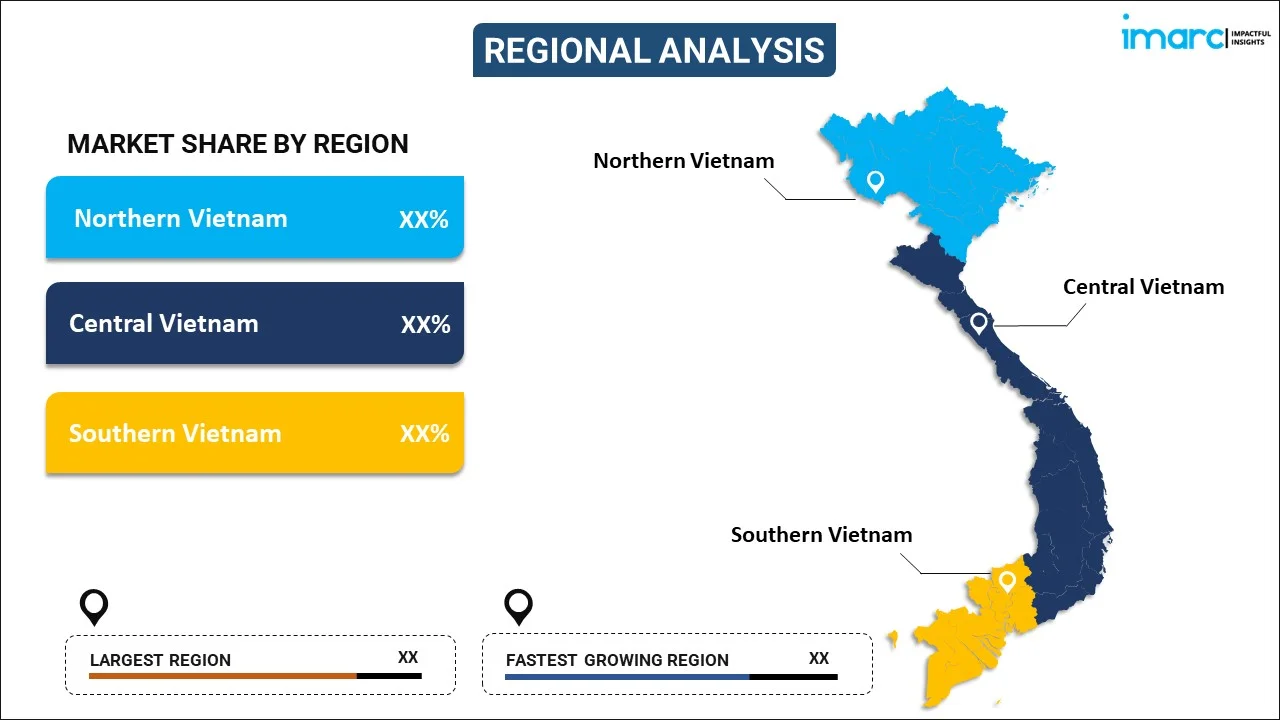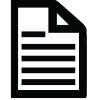IMARC made the whole process easy. Everyone I spoke with via email was polite, easy to deal with, kept their promises regarding delivery timelines and were solutions focused. From my first contact, I was grateful for the professionalism shown by the whole IMARC team. I recommend IMARC to all that need timely, affordable information and advice. My experience with IMARC was excellent and I can not fault it.
Read More
Vietnam Methanol Market Report by Application (Formaldehyde, Dimethyl Ether, Gasoline, Chloromethane, MTBE/TAME, Acetic Acid, and Others), and Region 2025-2033
Market Overview:
Vietnam methanol market size is projected to exhibit a growth rate (CAGR) of 3.40% during 2025-2033. The expanding chemical industry, along with the inflating need for safer fuel alternative, due to its low rate of evaporation and low radiant heat energy, is primarily driving the market growth.
|
Report Attribute
|
Key Statistics
|
|---|---|
|
Base Year
|
2024 |
|
Forecast Years
|
2025-2033
|
|
Historical Years
|
2019-2024
|
| Market Growth Rate (2025-2033) | 3.40% |
Methanol, also recognized as wood alcohol, is a transparent, combustible liquid with various applications, serving as a solvent, fuel, and antifreeze. This chemical compound, the simplest alcohol, comprises a methyl group (CH3) linked to a hydroxyl group (OH). Methanol can be manufactured using various methods, including the conversion of biomass, such as wood, through destructive distillation, or the catalytic conversion of synthesis gas derived from natural gas or coal. Methanol exhibits a property of being miscible in water, alcohol, ether, ketones, and other organic solvents, making it a valuable ingredient in various industries. It finds extensive use in the production of formaldehyde, acetic acid, dimethyl terephthalate (DMT), methyl tertiary butyl ether (MTBE), tertiary amyl methyl ether (TAME), dimethyl ether (DME), and biodiesel, among other products. Methanol's versatility and wide range of applications make it a significant component in numerous industrial processes and products.
Vietnam Methanol Market Trends:
The Vietnam methanol market is experiencing positive growth trends driven by several key factors. One of the significant drivers is the expanding automotive industry, where methanol is utilized as both a fuel for internal combustion engines and an essential antifreeze agent for automobile radiators. This automotive application contributes to the growing demand for methanol in the country. Furthermore, the energy sector plays a vital role in the market's development, as methanol is used to produce dimethyl ether (DME), a clean fuel alternative commonly used as a substitute for propane. The demand for clean and sustainable energy sources is boosting the adoption of DME, thereby driving the methanol market. An emerging trend in the market is the development and commercialization of renewable methanol. This innovative approach allows methanol to be produced from carbon dioxide (CO2) captured from industrial emissions or direct air capture, aligning with environmental sustainability goals and regulations. Moreover, methanol finds application in the production of various chemicals, including formaldehyde, acetic acid, methyl tert-butyl ether (MTBE), and dimethyl ether (DME), contributing significantly to its market growth. Overall, favorable government regulations, ongoing research and development activities, and the utilization of methanol in various industrial processes will continue to create promising opportunities in the Vietnam methanol market over the forecasted period.
Vietnam Methanol Market Segmentation:
IMARC Group provides an analysis of the key trends in each segment of the market, along with forecasts at the country level for 2025-2033. Our report has categorized the market based on application.
Application Insights:

- Formaldehyde
- Dimethyl Ether
- Gasoline
- Chloromethane
- MTBE/TAME
- Acetic Acid
- Others
The report has provided a detailed breakup and analysis of the market based on the application. This includes formaldehyde, dimethyl ether, gasoline, chloromethane, MTBE/TAME, acetic acid, and others.
Regional Insights:

- Northern Vietnam
- Central Vietnam
- Southern Vietnam
The report has also provided a comprehensive analysis of all the major regional markets, which include Northern Vietnam, Central Vietnam, and Southern Vietnam.
Competitive Landscape:
The market research report has also provided a comprehensive analysis of the competitive landscape in the market. Competitive analysis such as market structure, key player positioning, top winning strategies, competitive dashboard, and company evaluation quadrant has been covered in the report. Also, detailed profiles of all major companies have been provided.
Vietnam Methanol Market Report Coverage:
| Report Features | Details |
|---|---|
| Base Year of the Analysis | 2024 |
| Historical Period | 2019-2024 |
| Forecast Period | 2025-2033 |
| Units | US$ Million |
| Scope of the Report | Exploration of Historical and Forecast Trends, Industry Catalysts and Challenges, Segment-Wise Historical and Predictive Market Assessment:
|
| Applications Covered | Formaldehyde, Dimethyl Ether, Gasoline, Chloromethane, MTBE/TAME, Acetic Acid, Others |
| Regions Covered | Northern Vietnam, Central Vietnam, Southern Vietnam |
| Customization Scope | 10% Free Customization |
| Report Price and Purchase Option | Single User License: US$ 3699 Five User License: US$ 4699 Corporate License: US$ 5699 |
| Post-Sale Analyst Support | 10-12 Weeks |
| Delivery Format | PDF and Excel through Email (We can also provide the editable version of the report in PPT/Word format on special request) |
Key Questions Answered in This Report:
- How has the Vietnam methanol market performed so far and how will it perform in the coming years?
- What has been the impact of COVID-19 on the Vietnam methanol market?
- What is the breakup of the Vietnam methanol market on the basis of application?
- What are the various stages in the value chain of the Vietnam methanol market?
- What are the key driving factors and challenges in the Vietnam methanol?
- What is the structure of the Vietnam methanol market and who are the key players?
- What is the degree of competition in the Vietnam methanol market?
Key Benefits for Stakeholders:
- IMARC’s industry report offers a comprehensive quantitative analysis of various market segments, historical and current market trends, market forecasts, and dynamics of the Vietnam methanol market from 2019-2033.
- The research report provides the latest information on the market drivers, challenges, and opportunities in the Vietnam methanol market.
- Porter's five forces analysis assist stakeholders in assessing the impact of new entrants, competitive rivalry, supplier power, buyer power, and the threat of substitution. It helps stakeholders to analyze the level of competition within the Vietnam methanol industry and its attractiveness.
- Competitive landscape allows stakeholders to understand their competitive environment and provides an insight into the current positions of key players in the market.
Need more help?
- Speak to our experienced analysts for insights on the current market scenarios.
- Include additional segments and countries to customize the report as per your requirement.
- Gain an unparalleled competitive advantage in your domain by understanding how to utilize the report and positively impacting your operations and revenue.
- For further assistance, please connect with our analysts.

Benefits of Customization
Personalize this research
Triangulate with your data
Get data as per your format and definition
Gain a deeper dive into a specific application, geography, customer, or competitor
Any level of personalization
Get in Touch With Us
UNITED STATES
Phone: +1-631-791-1145
INDIA
Phone: +91-120-433-0800
UNITED KINGDOM
Phone: +44-753-714-6104
Email: sales@imarcgroup.com
 Inquire Before Buying
Inquire Before Buying Speak to an Analyst
Speak to an Analyst  Request Brochure
Request Brochure  Request Customization
Request Customization



.webp)




.webp)












